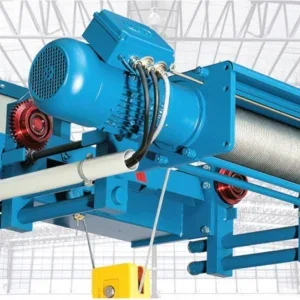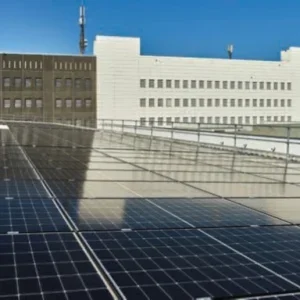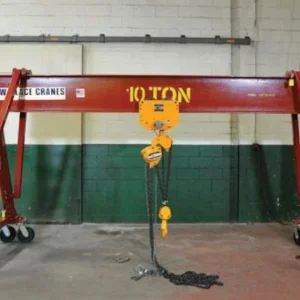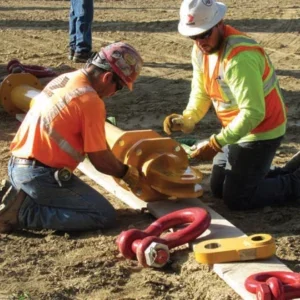More complex round slings may be formed from tubular web sections, the ends of which have been attached, typically by sewing. The tubular webs may be woven as a tube, or may be formed from a planar webbing that is sewn together longitudinally to form a tubular web.

During use, round slings may be rubbed against other objects, which may cause wear to the web and in some instances may tear the web and/or load bearing material, thereby reducing the strength of the sling as well as its longevity.
In such instances, ‘jackets’ have been added to the round slings. Such jackets are simply a second tubular web into which the first tubular web and/or load bearing material is inserted or woven together.
The outer tubular web may be made more abrasion resistant by using a particular weave or yarn, or by coating a portion of or the entire outer surface to make it rougher.
A typical construction technique for forming double-jacketed round slings involves inserting the inner tubular web section into the outer tubular web followed by inserting a load bearing material into the inner tubular web.
The ends of the inner tubular web and outer tubular web are then attached together in succession, preferably by sewing.
In accordance with the present invention the warp strands may be selected from the group consisting of nylon, polyester, nomex, kevlar, spectra, vectran, dyneema, tauron, or any yarn like material, and combinations thereof.
Technical illustrations
Figure 1 illustrates a web section (10) according to the present disclosure. As shown, the web section preferably has a tubular construction with a longitudinal centerline or axis “A.” Web section 10 may be woven with longitudinal warp strands (12) alternating with transverse weft strands (14).
Preferably, web section 10 is woven using a plain weave, double plain weave, triple plain weave, or combinations of the foregoing weaves. The elasticised weft strands (14) allow the diameter of tubular web section (10) to be expanded or stretched in the direction indicated by arrows “X,” and to return to its original diameter upon release.
In preferred embodiments, some or all weft strands (14) may be formed from an elasticised material. One type of yarn that has been found suitable is continuous filament 1000/2 denier polyester and 2850/1 denier texturised nylon.
In preferred embodiments, some or all warp strands (12) may be formed from a substantially inelastic material. In the present exemplary embodiment, each weft strand (14) is formed from an elasticised material, and each warp strand is formed from a substantially inelastic material.
‘Elasticised material,’ as used herein, means any woven or non-woven material that will return to substantially its original shape after deformation. Those of skill in the art will be able to select many suitable materials for the weft strands, which are available in a variety of tensile strengths from a variety of manufacturers. Thus, the degree of radial expansion of web section 10 in direction “X” may be varied by varying the quantity, size, material and constructions from which the weft strands are formed. For example, covering the elasticised material with textile yarns may change or limit its stretch characteristics.
Weft strands (14) are selected so that the final web section preferably has an elasticity at a minimum of 5%. This represents the percentage amount that the web section can be stretched in the “X” direction. In other words for a given width of section, with an elasticity of 5%, the web can be stretched 5% of that given amount. The preferred range of elasticity is 5% to 50%.
Figures 2 and 3 show a preferred embodiment of a section of an exemplary double-walled round sling (20) according to the present disclosure. Round sling 20 is preferably symmetrical and includes an outer tubular web section (22) having opposing ends (22e) and an inner tubular web section (24) having opposing ends (24e).
In general, web sections 22 and 24 each have substantially the same length, but this is not required, and there may be situations in which it is desirable or necessary for the lengths to be different. Inner tubular web section 24 is preferably positioned coaxially in outer tubular web section 22.
Preferably, both inner and outer tubular web sections (22 and 24) are constructed in the same manner as web section 10 (Figure 1). That is, inner and outer tubular web sections 22 and 24 each preferably include longitudinal warp strands (12) alternating with transverse weft strands (14).
Load bearing material
Round sling 20 may include at least one strand (26) of load bearing material positioned coaxially within inner tubular web section 24. Load bearing strand 26 preferably has substantially the same length as inner and outer tubular web sections 22 and 24, but this, again, is not required.
The quantity and tensile strength of the load bearing strand (26) positioned in inner tubular web section 24 determines, at least in part, the tensile and break strength of round sling 20. Thus, the tensile/breaking strength of round sling 10 may be varied by varying the type and quantity of strands (26) of load bearing material. As shown, the present embodiment includes a plurality of load bearing strands, each having a predetermined tensile/breaking strength.
It is possible that a single length of material other than a strand may be positioned coaxially in inner tubular web section 24 provided that round sling 20 meets the design requirements for tensile/breaking strength.
An improved method for constructing round sling 20 will now be described with reference to Figures 4-8; the method is facilitated by the particular construction of inner and outer tubular web sections.
Figure 4 shows round sling 20 with a plurality of load bearing strands (26) disposed in inner tubular web section 24, and with inner tubular web section 24 disposed in outer tubular web section 22, prior to attachment of ends 22e and 24e.
As shown, prior to attachment of ends 22e of web section 22, section 22 may be folded back at fold 22f to expose inner tubular web (24).
Thereafter, ends (24e) of inner tubular web (24) may be folded back at fold 24f to expose load bearing strands (26). Even though the present method is illustrated with the formation of folds (22f and 24f), it should be understood that the method may also be practiced by pushing back ends 22e and 24e without necessarily requiring the formation of a fold.
However, for ease of explanation, the method will be described using a folding technique. The amount of folding or pushing back will be determined on a case by case basis, but at a minimum should be sufficient to expose a sufficient length of load bearing strands.
As shown in Figure 5, in practicing the present method, the formation of folds (22f and 24f) is facilitated by the pliability of inner and outer tubular web sections, which stretch radially in the direction indicated by arrows “X.” Such radial stretching cannot be accomplished with other types of web sections, but may be accomplished with relative ease in the present method due to the elasticised weft strands (14).
Thus, the elasticised weft strands (14) increase the pliability of web sections 22 and 24, allowing them to be stretched or expanded in a radial direction for ease of folding and unfolding and/or pushing.
Inner tubular web section
As shown in Figure 6, folds 24f of inner tubular web section 24 may
be unfolded, and ends 24e may be attached, again, preferably by
sewing. If desired or necessary to obtain greater exposure of inner tubular web section 24 in order to facilitate attachment of ends (24e), outer tubular web section 24 may be folded back to a greater degree, or alternatively folded repeatedly back upon itself to from a plurality of folds 24f.
Again, the attachment of respective ends 24e of inner tubular web section 24 may be carried out with relative ease because ends 22e of outer tubular web section 22 are out of the way and do not interfere with the attachment step of the inner web section.
Finally, after attachment of ends (24e) of inner tubular web section (24), folds (22f) of outer tubular web section (22) may be unfolded as shown in Figure 7, and thereafter attached together as shown in Figure 8, again preferably by sewing.
Figure 9 shows a round sling (20) according to the disclosure being used in a customary manner. As shown, round sling 20 is suspended from a hook (30) and supports, for example, a cylindrical object (40).

Figure 1 – an expanded view of a portion of an exemplary web section according to the present disclosure.
Figure 2 – a side view of an exemplary round sling constructed from the web section shown in Figure 1, showing an inner tubular web section, an outer tubular web section, and a plurality of load bearing strands.
Figure 3 is a cross-sectional view of the round sling shown in Figure 2 as taken along line 3-3.


Figure 4 shows the round sling shown in Figures 2 and 3 prior to attachment of the webbing jackets.

Figure 5 shows the round sling illustrated in Figure 4 showing the manual expansion of the tubular web section in the radial direction indicated by the arrows.
Figure 6 shows the round sling of Figure 5 after the ends of the inner tubular web section have been attached to one another.

Figure 7 shows the round sling of Figure 6 after one end of the outer tubular web section has been unfolded.
Figure 8 shows the round sling of Figure 7 after the ends of the outer tubular web sections have been attached to one another.






